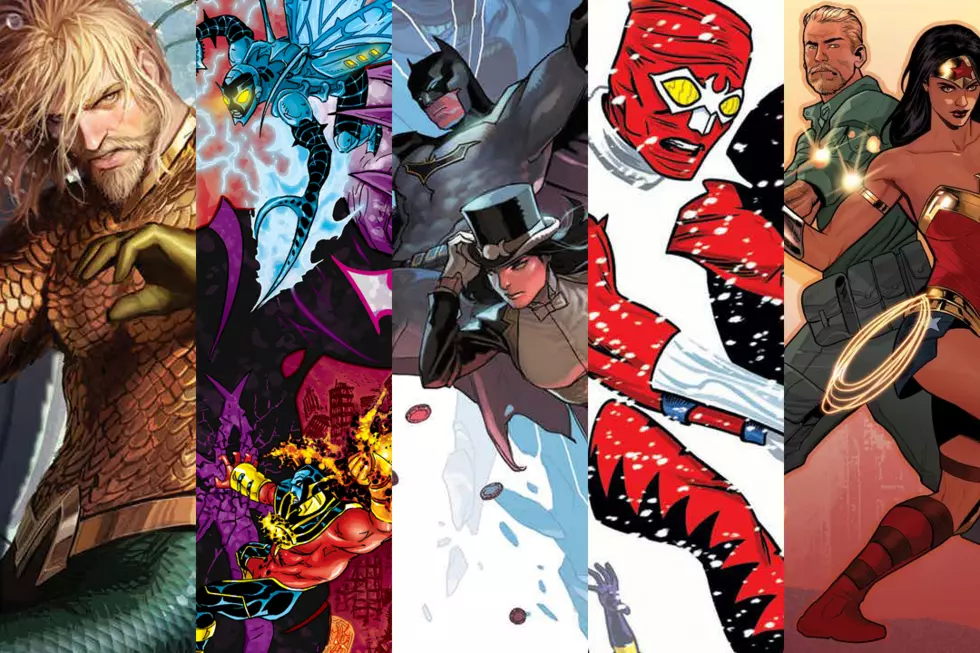![‘All a Little Mad’ is an Understatement: Joker’s Asylum Harley Quinn & Mad Hatter [Review]](http://townsquare.media/site/622/files/2010/06/jacovers.jpg?w=980&q=75)
‘All a Little Mad’ is an Understatement: Joker’s Asylum Harley Quinn & Mad Hatter [Review]

Sane people are dull. Sure, they're necessary. When you buy a coffee in the morning it's unsettling to have it served to you by someone whose left eye twitches, grins madly, cackles while using the coffee grinder and mumbles, "Oh yes, you'll pay," before turning to the rest of the line behind you and yelling "You'll all pay!" At tax time it's preferable to find an accountant who refrains from attempting to claim the invisible talking giant spider who he assures you lives in your house as an additional dependent. Indeed, most aspects of our day to day lives are made simpler by the exclusion of crazy people.
But on the other hand, removing the completely insane makes things thoroughly boring, as the institutionalized insane live far more interesting lives than you and I. Or at least they do in comic books, where severe mental disorders can be a stand-in for superpowers instead of tragically removing a person's ability to function in normal human society. But like I said before, normal human society's boring and who needs it? On to the parade of crazies! DC's issuing a second series of five "Joker's Asylum" one-shots this summer and this week marked the release of two such books. Writer James Patrick and artist Joe Quinones provide a delightful tale of twisted romance featuring Harley Quinn, while writer Landry Quinn Walker and artists Keith Giffen and Bill Sienkiewicz offer a disturbing glimpse into the psyche of Jervis Tetch, the Mad Hatter. Both one-shots do a great job of capturing the essence of the featured characters in a single story, both in the writing and the art.
If I had to pick a favorite of the two, it'd be Patrick and Quinones' "Harley Quinn". It tells the story of Harley's escape from Arkham Asylum on Valentine's Day, determined to make sure nothing stops her from spending a perfect romantic evening with the Joker. Unfortunately for Harley, she'll have to go through the mob, then the Gotham Police Department and finally Batman in order to make it to her puddin' before the night's over.

Patrick successfully channels the spirit of comic bubbly sociopathy that first made Harley such a hit when she was introduced on "Batman: The Animated Series," and the fact that he and Quinones are able to get away with more violence here than the cartoon ever could only serves to strengthen the book's comedic impact. I can't remember the last time I laughed so hard at a man getting shot in the knee. But only because I'm not trying particularly hard. A lot of the book's comic success is due to Quinones' ability to use Harley's facial expressions to push the laughs as far as they can go. This is pretty close to the perfect issue for fans of Harley's special brand of adorable mayhem.
Walker, Giffen and Sienkiewicz's "Mad Hatter" is a darker tale that manages to be a powerful and disturbing character study of the Batman villain who perhaps most deserves to be in an asylum. Certainly many of the Dark Knight's rogues gallery are not the kind of people anyone's likely to call sane. But there are few whose insanity causes as much internal conflict to them as Jervis Tetch's does. Two-Face, for example, tends to have his madness tempered into a controlled unpredictably. And the Joker himself has either reached a comfort level with his own total insanity or simply allowed it to swallow him completely. Whatever the case may be, he's rarely fighting against the forces that rage inside him, instead choosing to ride those currents of dementia wherever they happen to carry him.
Not the Mad Hatter. He often seems caught up in terrible internal struggles between his desire to control all the world around him and his wish to not do the terrible things he so often does. Because deep down he knows that he'll never be satisfied if the world is the way he wants it to be only because he's controlling everyone to make it that way. And it's that madness-driven conflict that's explored in this one-shot, to an often disturbing effect. Walker's stream-of-consciousness narration by the Hatter himself helps the reader gain an appreciation of the hectic, troubled workings of Tetch's mind. And the art by Giffen and Sienkiewicz, mixing the decrepit reality of Tetch's basement apartment with the visuals of a child's crayon-illustrated scrapbook, sets the tone of a mind with no firm grip on anything.
I'd recommend both books, but if you're a fan of either Harley or the Hatter these are must-reads. I suspect one of those groups is much larger than the other. Perhaps that wouldn't be the case if Jervis Tetch adopted a more skin-tight costume. Although perhaps my speculation on that matter shouldn't be trusted. I have a bit of the crazy myself sometimes.
More From ComicsAlliance



![How Conner And Palmiotti Reinvigorated Harley And Reimagined ‘The Jetsons’ [Interview]](http://townsquare.media/site/622/files/2017/03/Harley-Featured.png?w=980&q=75)

![Bill Sienkiewicz Provides FOC Variant Cover For ‘American Gods: Shadows’ #2 [Exclusive]](http://townsquare.media/site/622/files/2017/03/AMGODS0.png?w=980&q=75)
![Square Enix Shows Off Even More Amazing Alternate Marvel and DC Characters [Toy Fair 2017]](http://townsquare.media/site/622/files/2017/02/IMG_2545.jpg?w=980&q=75)
![DC Collectibles Shows Off Its Icons, Wonder Woman, and More [Toy Fair 2017]](http://townsquare.media/site/622/files/2017/02/IMG_2131.jpg?w=980&q=75)

